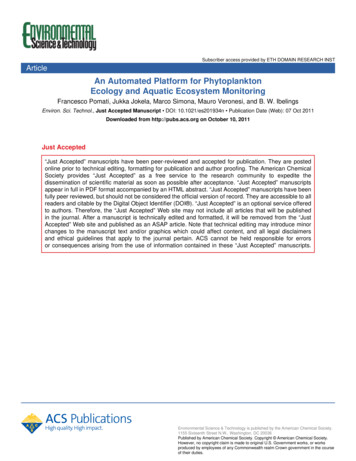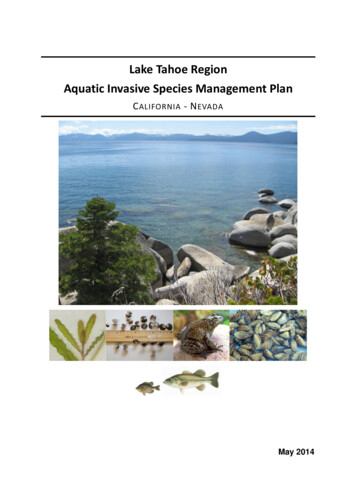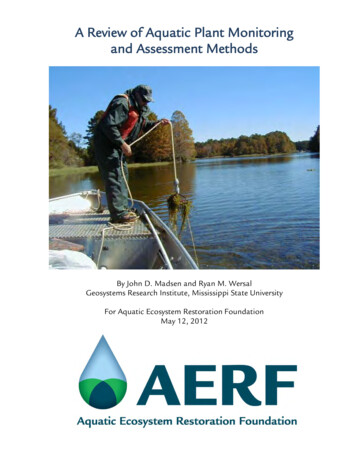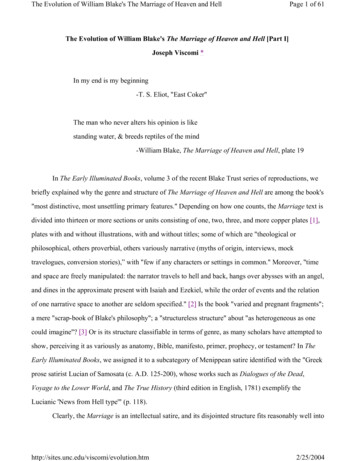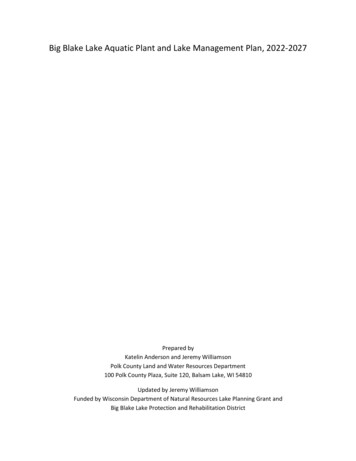
Transcription
Big Blake Lake Aquatic Plant and Lake Management Plan, 2022-2027Prepared byKatelin Anderson and Jeremy WilliamsonPolk County Land and Water Resources Department100 Polk County Plaza, Suite 120, Balsam Lake, WI 54810Updated by Jeremy WilliamsonFunded by Wisconsin Department of Natural Resources Lake Planning Grant andBig Blake Lake Protection and Rehabilitation District
We would like to thank the following for their contributions to this project. Asterisks indicate membersof the Lake Planning Committee.Big Blake Lake ResidentsJohn Belisle *Tom BordenSue Budd *Don Craft *Lisa DenneVicky DornerAdam ElliottJim FilkinsDennis GlennaMegan LangerPeggy Lauritsen *Jim MaxwellJim Mitchell *Shawn PerkinsSam Rivers *Shelley Rodriguez *Mike Rogge *Jeff SchoenickGerry Smith *Roxanne Smith *Cedric SollandSt. Croix Watershed Research StationMark EdlundWisconsin Department of Natural ResourcesKris LarsenJordan PetchenikAlex SmithUniversity of Wisconsin-River FallsLance Willson
Table of ContentsPurpose of the Study. 4Background Information on Lakes, Studies, and Management Plans . 5Introduction to Big Blake Lake . 6Lake Classification . 7Big Blake Lake Characteristics . 8Designated Waters and Sensitive Areas . 9Impaired Waters . 11Previous Lake Studies. 12Fisheries . 19Lake Resident Survey . 21Lake Level and Precipitation Monitoring . 27Lake Mixing and Stratification: Background Information . 28
Deep Hole Sampling Procedure . 30Dissolved Oxygen . 31Temperature . 33Specific Conductance (Conductivity) . 34pH . 35Secchi Depth . 37Phosphorus . 40Tributary and Outlet Phosphorus . 45Tributary and Outlet Phosphorus Budget . 47Nitrogen . 48Tributary and Outlet Nitrogen . 50Total Nitrogen to Total Phosphorus Ratio . 52Total Suspended Solids . 53Tributary and Outlet Total Suspended Solids . 54Chlorophyll . 55Trophic State Index . 56Phytoplankton . 59Blue Green Algae. 62Zooplankton . 64Harvesting and Curly-leaf Pondweed . 66Curly-leaf Pondweed Biomass and Turion Sampling . 67Point Intercept Aquatic Macrophyte Surveys . 70Land Use and Water Quality . 82Historical Land Use in the Big Blake Lake Watershed . 84Historic Land Use and Nutrient Loading in the Big Blake Lake Watershed . 85Watershed and Lake Modeling . 90Paleolimnological Study of Big Blake Lake . 96Areas Providing Water Quality Benefits to Big Blake Lake . 98Information and Education . 99Summary of Rules and Legislation . 102Aquatic Plant Laws and Rules . 109Management Options for Aquatic Plants . 1102
Lake Management Plan . 111Appendix FilesAppendix A: Lake Resident Survey and ResultsAppendix B: Lake Level and Precipitation MonitoringAppendix C: Deep Hole Chemical and Physical DataAppendix D: Tributary and Outlet Chemical and Physical DataAppendix E: Algae DataAppendix F: Zooplankton Data and ReportAppendix G: Curly Leaf Pondweed Biomass and Turion DataAppendix H: Point Intercept Aquatic Macrophyte Survey DataAppendix I: Modeling DataAppendix J: Sediment Core Data and Paleolimnoligical Study of Big Blake Lake ReportAppendix K: Newsletters, Presentations, and HandoutsAppendix L: Management Options for Aquatic PlantsAppendix M: Meeting Agendas and Materials3
Purpose of the StudyIn 2012, the Big Blake Lake Protection and Rehabilitation District applied for a Wisconsin Department ofNatural Resources Aquatic Invasive Species Education, Prevention, and Planning Grant. The grant wasawarded and data collection occurred in 2013, 2014, and 2015.The main purpose of the grant was to address the following problems: aquatic invasive species, nuisanceaquatic plant growth, algae blooms, impaired water clarity, and a lack of education and data.Methods and activities completed through this grant award include: Lake resident surveyIn-lake physical and chemical monitoringTributary monitoringPhytoplanktonZooplanktonAquatic plant point intercept surveysCurly-leaf pondweed biomass and turion monitoringWatershed delineation, land use determination, and modelingParticipation in aquatic invasive species statewide programs: Citizen Lake Monitoring Networkfor AIS and Water Quality, Bait Dealer Initiative, and Clean Boats, Clean Waters Communication of information: the Blake Lake Bugle Newsletter, pontoon classrooms, anddistribution of AIS flyers Development of Aquatic Plant Management PlanIn 2013, the Big Blake Lake Protection and Rehabilitation District applied for a Wisconsin Department ofNatural Resources Large Scale Lake Management Planning Grant to collect a sediment core on Big BlakeLake.Methods and activities completed through this grant award include: Sediment core collectionSediment phosphorusDiatom analysisMacrofossilsZooplanktonPigmentsBiogenic silica analysisHistorical land use determination and modelingDevelopment of a Lake Management PlanThe following report details the methods and activities completed through both grant awards.4
Background Information on Lakes, Studies, and Management PlansLakes are a product of the landscape they are situated in and of the actions that take place on the landwhich surrounds them. Factors such as lake size, lake depth, water sources, and geology all causeinherent differences in lake quality. As a result, lakes situated within feet of others can differ profoundlyin the uses they support.A landscape can be divided into watersheds and subwatersheds. These areas define the land that drainsto a particular lake, flowage, stream, or river. Watersheds that preserve native vegetation and minimizeimpervious surfaces (cement, concrete, and other materials that water can’t permeate) are less likely tocause negative impacts on lakes, rivers, and streams. This arises because rain and melting snoweventually end up in lakes and streams through surface runoff or groundwater infiltration. Rain andmelting snow entering a waterbody is not inherently problematic. However, water has the ability tocarry nutrients, bacteria, sediments, and chemicals into a waterbody. These inputs can impact aquaticorganisms such as insects, fish, and wildlife and—especially in the case of the nutrient phosphorus—fuelproblematic algae blooms.Lake studies often examine the underlying factors that impact a lake’s health, such as lake size, depth,water sources, and the land use in a lake’s watershed. Many forms of data can be collected andanalyzed to gauge a lake’s health including: physical data (oxygen, temperature, etc.), chemical data(including nutrients such a phosphorus and nitrogen), biological data (algae, zooplankton, and aquaticplants), and land use within a lake’s watershed. Additionally, sediment cores can be used to determinehow a lake has changed over the course of hundreds of yearsLake studies identify challenges and threats to a lake’s health along with opportunities for improvement.These studies identify practices already being implemented by watershed residents to improve waterquality and areas providing benefits to a lake’s ecosystem. Additionally, these studies quantify practicesor areas on the landscape that have the potential to negatively impact the health of a lake and identifybest management practices for improvement.The end product of a lake study is a Lake Management Plan which identifies goals, objectives, andaction items to either maintain or improve the health of a lake. These goals should be realistic based oninherent lake characteristics (lake size, depth, etc.) and should align with the goals of watershedresidents.An Aquatic Plant Management Plan is similar to a Lake Management Plan, although the goals,objectives, and action items pertain specifically to aquatic plants.Both types of management plans are designed to be working documents that are used to guide theactions which take place to manage a specific lake.5
Introduction to Big Blake LakeBig Blake Lake1 is a 208 acre lake located in the Town ofGeorgetown2 in Polk County, Wisconsin, approximately 80 milesnortheast of the Twin Cities metropolitan area. The area of landthat drains to a lake is called a watershed. Big Blake Lake issituated within the Upper Apple River Watershed, which is part ofthe St. Croix River Basin. The Upper Apple River Watershed is thelargest watershed in Polk County, totaling approximately 125,074acres in size.On a smaller scale, the area of land that drains to Big Blake Lake,or the Big Blake Lake watershed, is 20,066 acres in size. Thedrainage basin: lake area ratio (DB: LA) compares the size of alake’s watershed to the size of a lake. If a lake has a relativelylarge DB: LA then surface water inflow (containing nutrients andsediments) occurs from a large area of land relative to the area ofthe lake. The DB: LA for Big Blake Lake is approximately 96:1.The main inlet for Big Blake Lake is a channel flowing directly from Little Blake Lake on the southeast endof the lake. Additionally, Big Blake Lake receives water from an inlet located on the north side of thelake. This tributary flows from Lost Lake and is called Lost Creek. The lake’s outlet is located on thenorthwest side of Big Blake Lake and flows to the Apple River via Fox Creek.Lakes are classified according to their primary source of water and how that water enters and leaves thesystem. Big Blake Lake is defined as a drainage lake, or a lake with an inlet and an outlet. Drainage lakesreceive most of their water from the surrounding watershed in the form of stream drainage, have aprominent inlet and outlet that move water through the system, and commonly have high nutrientlevels due to inputs from the watershed.The residence time is the average amount of time water remains in a body of water. The residence timefor Big Blake Lake is 0.10 year, meaning that water is replaced approximately every 36 days.3There are two ramp public access sites on Big Blake Lake located on the northeast and southwest sidesof the lake.The Big Blake Lake Protection and Rehabilitation District was formed in 1976 in response to concernsabout algae blooms and aquatic plant problems. The District includes approximately two hundredtwenty-two residences. The majority of the shoreline property on Big Blake Lake is parceled into 100foot lots, although a moderate tract of forested land remains on the east side of the lake.1Waterbody ID (WBIC) 2627000T35N, R16 W, Sec. 22, 26, 273Ibid26
Lake ClassificationLake classification in Polk County is a relatively simple model that considers: Lake surface areaMaximum depthLake typeWatershed areaShoreline irregularityExisting level of shoreline developmentThese parameters are used to classify lakes as class one, class two, or class three lakes. Big Blake Lake isclassified as a class one lake.Class one lakes are large and highly developed.Class two lakes are less developed and more sensitive to development pressure.Class three lakes are usually small, have little or no development, and are very sensitive to developmentpressure.7
Big Blake Lake CharacteristicsBig Blake Lake 4Area: 208 AcresMaximum depth: 14 feetMean depth: 9 feetBottom: 55% sand, 0% gravel, 0% rock, and 45% muckHydrologic lake type: Drainage 5Total shoreline: 6.65 milesInvasive species: Curly-leaf pondweed, Chinese mystery snail, and banded mystery snailFish: Musky, panfish, largemouth bass, northern pike, and walleyeBoat landings: 2Trophic Status: EutrophicOligotrophic lakes are generally clear, deep, and free of plants and large algae blooms.Mesotrophic lakes lie between oligotrophic and eutrophic lakes. They usually have productivefisheries, healthy plant life, and occasional algae blooms.Eutrophic lakes are generally high in nutrients and support a large number of plant and animalpopulations. They are usually very productive and subject to frequent algae blooms. Lakes can alsobe hypereutrophic. Hypereutrophic lakes are characterized by dense algae communities and canexperience heavy blooms throughout the ail.aspx?wbic 2627000&page moreA drainage lake is fed by streams, groundwater, precipitation, and runoff and drained by a stream8
Designated Waters and Sensitive AreasA designated water is a waterbody with special designations that affect permit requirements.Big Blake Lake is designated as an Area of Special Natural Resource Interest (ASNRI) Endangered,Threatened, or Special Concern Lake. The Natural Heritage Inventory Program identifies waters orportions of waters inhabited by any endangered, threatened, special concern species, or uniqueecological community identified in the Natural Heritage Inventory.An Integrated Sensitive Area Survey Report was completed for Big Blake Lake in August, 2000. Thissurvey identified three areas of Big Blake Lake that merit special protection of aquatic habitat. Sensitivearea A is located on the northern end of Big Blake Lake and covers approximately 400 feet of shorelineand extends out as far as 100 feet, sensitive area B is located at the northeastern end of Big Blake Lakeand covers approximately 400 feet of shoreline and extends out as far as 150 feet, and sensitive area C islocated at the southeastern end of Big Blake Lake and the southwestern end of Little Blake Lake andencompasses the channel between the two lakes. 6Wild rice was documented in sensitive areas A and C. Big Blake Lake is recognized as a wild rice water inthe Wisconsin Ceded Territory.7Wild rice, white water lily, and yellow water lily in sensitive area A6Blake and Little Blake Lake Sensitive Area Survey Report and Management Guidelines, Wisconsin Department ofNatural Resources, 20007Wisconsin Ceded Territory Manoomin Inventory, GLIFWC Project Report, Peter David, 20109
10
Impaired WatersWisconsin lakes, rivers, and streams are managed to determine if their conditions are meeting state andfederal water quality standards. Water samples are collected through monitoring studies and resultsare compared to guidelines designed to evaluate conditions as compared to state standards. Generalassessments place waters in four different categories: poor, fair, good, and excellent. The results ofassessments can be used to determine which actions will ensure that water quality standards are beingmet (anti-degradation, maintenance, or restoration).If a waterbody does not meet water quality standards, it is placed on Wisconsin’s Impaired Waters Listunder the Federal Clean Water Act, Section 303(d). Every two years, the State of Wisconsin is requiredto submit list updates to the United States Environmental Protection Agency for approval.Waterbodies can be listed as impaired based onpollutants such as total phosphorus, totalsuspended solids, and metals. Wisconsin watersare each assigned four uses (fish and aquatic life,recreation, public health and welfare, andwildlife) that carry with them a set of goals.Impairment thresholds vary for each use andvary based on lake characteristics such aswhether a waterbody is shallow versus deep andwhether a waterbody is a drainage lake versus aseepage lake. Big Blake Lake is classified as ashallow drainage lake that does not stratify. 8Big Blake Lake was assessed during the 2016listing cycle and proposed for listing for thepollutant total phosphorus and the impairmentof excess algal growth. The general condition issuspected poor.Total phosphorus sample data exceeded the 2016 Wisconsin’s Consolidated Assessment and ListingMethodology (WisCALM) listing thresholds for recreational use (40 µg/L) but not for fish and aquatic lifeuse (100 µg/L). Chlorophyll sample data exceeded the 2016 WisCALM listing thresholds for recreationaluse (30% of days in the sampling season have nuisance algal blooms with chlorophyll values greater than20 µg/L) and fish and aquatic life use (60 µg/L).98Listing thresholds can be found in: Wisconsin 2014 Consolidated Assessment and Listing Methodology (WisCALM)Clean Water Act Section 305(b), 314, and 303(d) Integrated Reporting, Wisconsin Department of NaturalResources, September 20139http://dnr.wi.gov/water/waterDetail.aspx?key 1655811
Previous Lake StudiesPast studies on Big Blake Lake include: Blake Lake Polk County Feasibility Study Results: Management Alternatives, WisconsinDepartment of Natural Resources Office of Inland Lake Renewal, 1981 Blake Lake Macrophyte Surveys and Management Plan, Barr Engineering, 1998 Blake and Little Blake Lake Sensitive Area Survey Report and Management Guidelines, WisconsinDepartment of Natural Resources, 2000 2004 Big Blake Lake Water Quality and Technical Report, Aquatic Engineering, Inc., 2005 2004 Big Blake Lake Aquatic Plant Survey Technical Report and Management Plan, AquaticEngineering, Inc., 2005 Aquatic Macrophyte Surveys, Polk County Land and Water Resources Department, 2006-2012Blake Lake Polk County Feasibility Study Results: Management Alternatives, 1981Office of Inland Lake Renewal, Wisconsin Department of Natural ResourcesThe Big Blake Lake Protection and Rehabilitation District was formed in 1976. In response, a study of BigBlake Lake and its watershed was initiated by the Office of Inland Lake Renewal, Wisconsin Departmentof Natural Resources (November 1978-October 1979).The three main objectives of this study were to: define a nutrient budget, define a water budget, andcharacterize in-lake chemistry and biological processes for Big Blake Lake.The following sources of phosphorus loading were identified and used to develop a nutrient budget: Surface runoff: 1,190 kg/yr, 90% Approximately 70% of this loading originated from the Straight River Watershed Groundwater: 72 kg/yr, 5% Septic system leachate: 38 kg/yr, 3% Atmospheric deposition: 30 kg/yr, 2%Additionally, the study determined that the net release of phosphorus from sediments was 149 kgduring the study period. Data indicated that Big Blake Lake was over half full of sediment, with amaximum sediment thickness of 25 feet.The study classified Big Blake Lake as a productive, eutrophic body of water based on total phosphorus,secchi depth, and chlorophyll a. Dissolved oxygen remained adequate throughout the winter monthsand thermal stratification was not recorded during the summer months. The nitrogen to phosphorusratio was 13:1, indicating that phosphorus is the most important nutrient for limiting algae populations.At the time of this study, Big Blake Lake contained a diverse group of macrophytes including eightsubmerged species, three emergent species, and six floating leaf species. With the exception of densecurly-leaf pondweed in the northwest portion of the lake, macrophyte densities were light to moderatethrough June. However, by August macrophyte densities were elevated in many areas of the lake with12
curly-leaf pondweed beds being replaced with coontail. Approximately 10% (25 acres) of Big Blake Lakewas covered with aquatic macrophytes during the study.Management alternatives suggested in this study include: improving the water quality of Big RoundLake, chemically removing phosphorus from the Straight River, diverting the Straight River south toWhite Ash Lake, controlling weeds with herbicides or harvesting, and dredging.Blake Lake Macrophyte Surveys and Management Plan, 1998Barr EngineeringIn 1996 the Big Blake Lake District approached the Wisconsin DNR to discuss options for plantmanagement. In response, the DNR suggested that the District complete a macrophyte survey and amacrophyte management plan for the lake. As a result, Barr Engineering completed macrophytesurveys during June and July 1997.Macrophytes were surveyed using a series of 29 transects at approximately 500 foot intervals along theshoreline. Each transect was divided into depth categories of 0-1.5 feet, 1.5-5 feet, and 5-10 feet (or themaximum rooting depth), with four rake samples taken at each depth category.The study determined that the total area of macrophyte growth was 122 acres (49% of the lake surfacearea) in June and 120 acres (49% of the lake surface area) in July. This compares with macrophytegrowth covering only 25 acres (10% of the lake surface area) in 1979. In the 18 years between the twosurveys, macrophyte coverage in Big Blake Lake increased by nearly 100 acres.A total of 21 species were found in Big Blake Lake with approximately 8-9 species being found in eachtransect. In general, each plant had a low individual density, but because there were a large number ofspecies found at each site, overall plant growth was moderate to high. The study determined thatdiversity was similar when comparing 1979 and 1997 data. In both June and July 1997, the diversityindex was 0.89.Curly-leaf pondweed, the only invasive plant located in the survey, was found in approximately 52% ofthe sample transects during June and approximately 48% of the sample transects during July. Ingeneral, densities remained low, although occasionally curly-leaf pondweed was found at higherdensities. The study indicated that native species were relatively successful in competing with curly-leafpondweed.Barr Engineering also surveyed members of the Big Blake Lake District to determine: residentunderstanding of functions and values of aquatic plants, uses of the lake, perceived impairment of lakeuses by aquatic plants, and aquatic plant management preferences. Seventy-seven responses werereceived (31% response rate).The primary uses for Big Blake Lake were fishing (94%), viewing (82%), swimming (70%), powerboating(47%), and canoeing (43%). The primary use impairments caused by plants were swimming (62%) andfishing (60%). Over half of respondents (56%) had removed or attempted to remove plants around theirdocks or along their shorelines. More respondents were opposed to the use of chemicals to removeaquatic plants from the lake (39%) as compared to mechanical harvesting of plants (23%). Over half ofrespondents (57%) indicated that the District should not own and operate a weed harvester. Most13
respondents (88%) recognized that aquatic plants have value, with high levels of importance for fishshelter and high to medium levels of importance for fish food.The six aquatic plant management goals developed for Blake Lake included: Improve navigation within the lake through areas containing dense plant bedsRemove or limit current exotic plants (i.e. curly-leaf pondweed)Preserve native species and prevent introduction of additional exotic speciesPreserve and/or improve fish and wildlife habitatProtect and/or improve quality of the resources for all to enjoy (i.e., people, fish, wildlife)Minimize disturbance of sensitive areas (i.e. fish and wildlife)The management plan developed for Big Blake Lake was based upon the need to: provide reasonableaccess to the lake for residents living adjacent to very dense plant growth, control curly-leaf pondweedgrowth, preserve the current macrophyte community, and prevent the introduction of additionalinvasive species to Big Blake Lake.The resulting management plan included: A harvesting plan for approximately 5 acres, with channel width restricted to 20 feetHerbicide treatment for approximately 60 acres of curly-leaf pondweedEducation programs to increase understanding of the function and roles of native plantcommunities and the threat that invasive species poseA plan to control the introduction of invasive species including: boat inspections; littoral areainspections; informational meetings; and boat launch signage, bulletin boards and brochureswith educational informationEvaluation program to monitor the effectiveness of the plan and resurvey the plant communityevery five yearsBlake and Little Blake Lake Sensitive Area Survey Report and Management Guidelines, 2000Wisconsin Department of Natural ResourcesA lake sensitive area survey was completed on Big Blake Lake on August 17th, 2000. The report indicatedthree sensitive areas in Big Blake Lake.Sensitive area A is located at the northern end of Big Blake Lake and covers approximately 400 feet ofshoreline and extends out as far as 100 feet. The area encompasses the alder thicket and open/shallowwater wetland area north of the boat launch. The majority of the shoreline in this area is considered“wild” with little or no development and high scenic beauty.Sensitive area B is located at the northeastern end of Big Blake Lake and covers approximately 400 feetof shoreline and extends out as far as 150 feet. The majority of the length is dominated by a shallow oropen water wetland which has protected the area from the negative impacts of improperly developedshorelines.14
Sensitive area C is located at the southeastern end of Big BlakeLake and the southwestern end of Little Blake Lake andencompasses the channel between the two lakes. The majorityof the length is dominated by deep marsh and shallow or openwater wetland which has protected the area from the negativeimpacts of improperly developed shorelines. However, somedeveloped shorelines with minimal buffers do exist in the ar
the lake. The DB: LA for Big Blake Lake is approximately 96:1. The main inlet for Big Blake Lake is a channel flowing directly from Little Blake Lake on the southeast end of the lake. Additionally, Big Blake Lake receives water from an inlet located on the north side of the lake. This tributary flows from Lost Lake and is called Lost reek.



